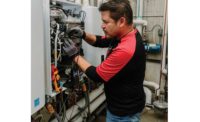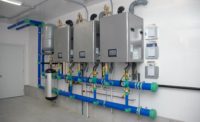Everyone wants to get the most bang for their buck, and commercial building owners are no different. As building standards increasingly focus on efficiency and consumer awareness of the benefits of energy efficient products grows, high-efficiency water heaters continue to gain traction in the market.
Smart systems
Keith Kuliga Jr., product manager — commercial products for Bradford White Water Heaters, points to two key trends influencing the commercial water heater market today: Remote monitoring capabilities, often referred to as building management systems (BMS), and the transition to high-efficiency products.
“Many businesses with a building management system are enjoying the benefits of remote monitoring to control different appliances or equipment,” he says. “BMS technology was first employed to monitor and control lighting, the power grid, security systems, fire protection and HVAC. Using BMS to monitor water heating operations is a relatively new development for tank-type water heaters, and is continuing to build momentum. We are also seeing more BMS integration on volume water heaters for domestic hot water and boilers for hydronic heating.
“The other trend is high efficiency,” Kuliga Jr. adds. “When you compare the energy efficiency of a standard efficiency gas water heater to a high-efficiency gas unit, the difference can range from 10% to 17%. Even though a high-efficiency gas water heater is more expensive to buy, depending on the water usage of a business, the potential for operational savings is significant over the long-term, so you can get a good payback.”
Kuliga Jr. notes the opportunity for significant energy savings and the ability to interact with water heaters remotely is driving these trends.
“Additionally, different policies are driving towards higher efficiency products, such as condensing gas water heaters and heat pump water heaters (HPWH),” he adds. “As the market drives towards these higher efficiency products, it is requiring more sophisticated combustion systems, advanced heat exchanger designs and expanding the breadth of HPWHs available to meet the needs of various commercial applications.”
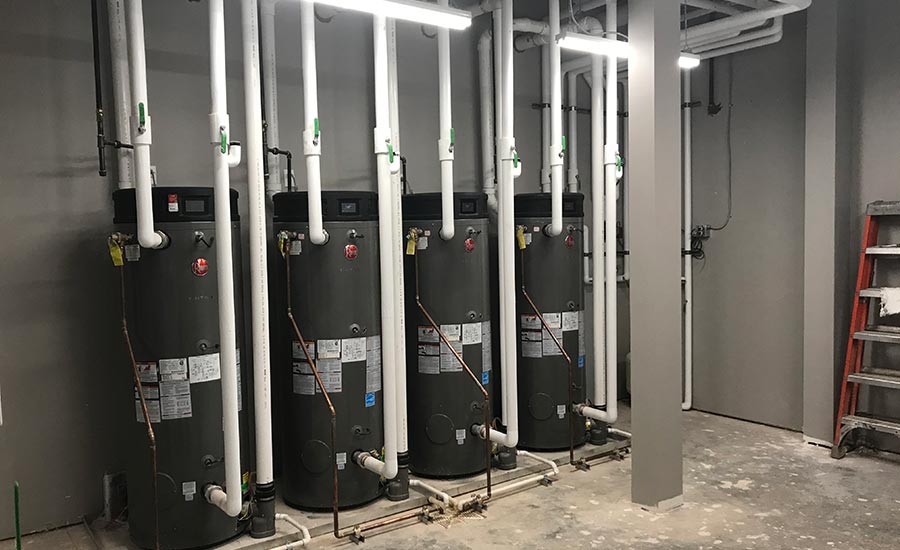
Rheem Triton commercial water heaters are installed with built-in smart monitoring technology and a leak detection and prevention system.
Decarbonization and sustainability
Paul Pohl, product manager, commercial new product development for A. O. Smith Corp., notes that though it is not yet reflected in terms of sales at the moment, he is seeing a lot of interest and government activity regarding electrification, also known as decarbonization.
“Products that fit into that category haven't really entirely taken off yet, but that's where the commercial market seems to be headed,” he explains. “In response to that, we've introduced more than 20 new heat pump water heater products during the past couple of years. And they include both split system heat pumps and a unitary, or integrated heat pumps — that's a heat pump with an integrated storage tank.”
Despite the interest in electrification, natural gas water heaters continue to lead the market sales, Pohl notes. In that regard, there is a trend toward larger Btu units. A. O. Smith, in trying to meet that need, introduced new 750,000 and 1 million Btu Cyclone XL series water heaters to compliment its lower Btu counterparts.
“Not only is the federal government looking at electrification, but we're now seeing a lot of states more active than ever, especially along the West Coast and in the Northeast,” Pohl says. “For the larger Btu gas units, that trend seems to be driven by the fact that mechanical rooms are getting smaller and smaller. For example, our new 750,000 and 1 million Btu Cyclone models have the same footprint as our 300,000 through 500,000 Btu units.”
According to Mike Juhnke, product program manager for Lochinvar, it’s more about greenhouse gas reduction at the moment as much as anything else.
“It’s kind of leading us down a path of set products,” he says. “Heat pumps are trending. We're looking at co-generation equipment that heats water and produces electricity. And then, of course, the efficiency of the products is at an all-time high. The trend as I see it is this drive to reduce or eliminate greenhouse gas products, not necessarily the products themselves, but the emissions. We're moving toward a decarbonation or electrification, and the push is in some areas more than others. The reality of the situation is many of those goals are unattainable in reality because the grid is not there. At the end of the day, we're going to end up with a hybrid approach in stages.”
Both water heater efficiency and return on investment post-installation continue to be top-of-mind among commercial customers, explains Rodney Pugh, senior manager — Florida, Commercial Growth for Rheem Manufacturing.
“Sustainability, and more specifically, decarbonization, continues to be a hot trend that we believe will only continue to accelerate,” he says. “California is known for pushing the envelope of sustainability-focused policies, and the state’s emphasis on Ultra Low-NOx products is only one example of this influence. Recently, California added new incentives for heat pump water heaters to mitigate emissions and improve air quality. Now, many other areas of the country are looking to potentially provide incentive programs for these sustainable products.”
Pugh points to Rheem’s electric heat pump water heaters as an example.
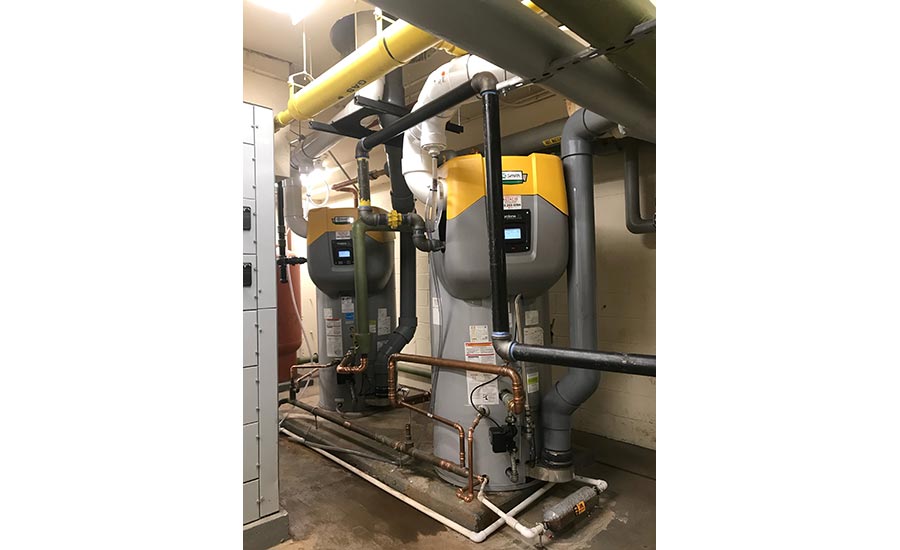
Two A. O. Smith Cyclone XL units are installed in a 25-story apartment building in New Rochelle, New York. These products feature 1 million Btu/h, and have a smaller footprint than two 500,000 Btu/h models. Rugged stainless steel construction, glass-lining and powered anodes provide superior corrosion resistance, while iCOMM remote monitoring provides detailed diagnostic fault notifications and control of the set point and differential via the A. O. Smith app.
“They are 350% more efficient than standard heat pumps and have the lowest cost use, making them an easy choice for many commercial applications, especially in areas that offer environmental incentives,” he explains. “However, factors such as enhanced ongoing maintenance, greater space requirements and up-front cost can limit the use of this technology in commercial applications, but engineers can often find efficient, environmentally friendly and sustainable solutions through high-efficiency gas fire options as well.”
According to Pugh, there is currently a real focus on environmental consciousness and mitigating society’s impact on the planet.
“Today, and as a crucial element of our A Greater Degree of Good sustainability initiative, Rheem is leading the decarbonization movements in our industries through intelligent products that empower sustainable living, implementing responsible processes that minimize waste, and advocating for change through training, education and policy efforts. We know our actions can have a significant impact on the world around us, which is why we’re committed to leveraging our scale and expertise to enable Rheem’s customers and employees to live and work sustainably.
“Similarly, many of Rheem’s commercial customers are focused on their own environmental consciousness and actively seek ultra-high-efficiency products as a great way to minimize their business’s environmental impact,” Pugh continues. “Ultra-high-efficiency water products also offer significant cost-savings over the lifespan of the unit, so a company’s bottom line can also play an important role in validating an investment in this technology.”
Efficiency is influencing many, if not all areas of design, Pugh adds.
“One area we are seeing a larger focus on now is a shift from PVC to other materials, as there are innovative new venting options on the market that can be more ideal with temperature requirements needed to support water heaters,” he says. “In addition, combustion technology has come a long way, and the products designed today provide commercial customers with an incredible return on investment due to the efficiency, while also reducing emissions to help the business meet its sustainability goals.”

Bradford White's Kuliga Jr. explains that as the market drives toward higher efficiency products, it is requiring more sophisticated combustion systems, advanced heat exchanger designs, and expanding the breadth of heat pump water heaters available to meet the needs of various commercial applications.
COVID-19 impacts
The COVID-19 pandemic affected just about every industry, especially in the commercial sector as buildings were closed or shut down for extended periods of time.
“Overall, the pandemic drove a greater awareness of the critical need for reliable hot water for health and sanitization in various types of facilities,” Kuliga Jr. says. “For the majority of 2020, it caused commercial building construction to be slowed, even temporarily halted, given the many uncertainties. Now, as we emerge from the pandemic, supply chain challenges remain across many industries, and the availability of plumbing and HVAC products has tightened up, which is probably the more significant short to mid-term impact at this time.”
Though the effects of COVID-19 were felt, business has not been terrible, Juhnke notes.
“Certain segments were hit more than others — the hospitality and restaurant industries especially. However, Lochinvar does a lot of business with the Disney Corp., and that business has been strong. Other parts of our business have been as strong or stronger than ever, so it’s been a very interesting year. One of the things we lost was direct contact with engineers and mechanical contractors, and by direct, I mean bringing them into our facilities. We’ve been scheduling virtual trainings, but you reach a point — and I’ve heard this term before and I know I’ve had it, too — of Zoom fatigue. We estimate we’ve done Zoom calls with close to 2,500 people last year. We’re looking forward to getting back to that direct contact.”
Pohl notes on the residential side, COVID-19 lockdowns pushed residential water heating sales across the country, mostly due to the fact people were stuck at home and using more hot water, which resulted in more equipment failures as well as more time to address replacement. However, on the commercial side, the market was down about 10%.
“It was primarily down due to COVID-19’s hit on restaurant and hospitality industries, as well as elsewhere,” he says. “Fortunately, we've almost completely rebounded from the drop in commercial sales up to this point. And there even seems to be some additional pent-up demand that that we're beginning to see within the last couple of months.”
The pandemic has shown how resilient the commercial water heating industry truly is and what a critical service the plumbing industry provides, according to Pugh.
“Hot water is essential to sanitary practices, especially in commercial environments, such as restaurants, where having a reliable hot water source allows us as a country continue to combat this pandemic,” he says. “We have continued to be innovative in our approach with our commercial customers to solve their ongoing hot water needs. Whether it was supplying outdoor handwashing stations or retrofitting restrooms for increased hot water flow from a new tankless unit that fit in a space constrained installed, we worked to rapidly provide solutions so they could stay in business and continue to serve their customer base with as little downtime as possible.”

Lochinvar’s updated line of ARMOR Condensing Water Heaters is available in a total of 10 models, ranging from 399,000 to 4 million Btu/h. The larger input models are constructed with superior grade 316L stainless-steel, which reduces heat loss and provides a greater performance of up to 99% thermal efficiency and reliability for large commercial applications. The product features a 10:1 turndown ratio and direct vent flexibility up to 150 feet in floor mount, wall mount, indoor, outdoor and indoor/outdoor convertible options, making it ideal for a variety of installations, the company notes.
What engineers should know
Even as the country emerges from the pandemic, many businesses and their customers are still operating remotely, Kuliga Jr. notes.
“Engineers are very conscious of this and want to specify equipment that maximizes efficiency while offering businesses the ability to monitor and control remotely,” he says. “High-efficiency products coupled with BMS integration further maximize savings. Monitoring appliance performance also allows for quick troubleshooting assistance thereby reducing downtime.
It’s also important for engineers to keep in mind that many businesses were hit hard financially during the pandemic, Pohl explains.
“While it's important to them to reduce their operating expenses by way of using more energy efficient equipment as a means of savings in the long-term, that recent hit financially due to COVID-19 lockdowns really seems to have an impact on their concern about seeing lower upfront equipment costs,” he says. “So while they have an interest in long-term savings, there seems to be a consensus that there's a lot of concern about keeping those upfront equipment costs lower, at least for the time being. Higher efficiency products are typically higher priced than lower efficiency products. So there may be some customers that are leaning more towards the lower priced upfront costs versus the longer payback solution offered by a higher energy efficient product.”
As industries continue to rebound, more attention will be given to the higher priced, higher efficiency products, Pugh notes.
“It's going to take us a little bit of time to get there,” he adds. “Also worth mentioning is the fact that current supply chain issues — which are being felt around the world in all industries — are having a real impact on profitability times. As somebody who's caught up in the backlash of that, trying to keep customers happy on a day to day basis, I would caution specifiers that they may want to consider doing what they can to influence early ordering of equipment, not just water heaters, but all of the equipment types that are going onto their projects.”
According to Pugh, sanitary practices and meeting the hot water demands of each commercial application remain at the forefront of any specifying engineer’s mind today.
“In addition to sanitization, engineers and commercial customers are focused on installing a reliable unit that is energy efficient to provide a strong return on investment,” he says. “Engineers are often looking for sustainable solutions that reduce emissions and provide a safe environment for the commercial business’s customers. Also, elements such as the footprint for install and access for maintenance are also key considerations to providing the commercial customer with the ideal unit for their building.”
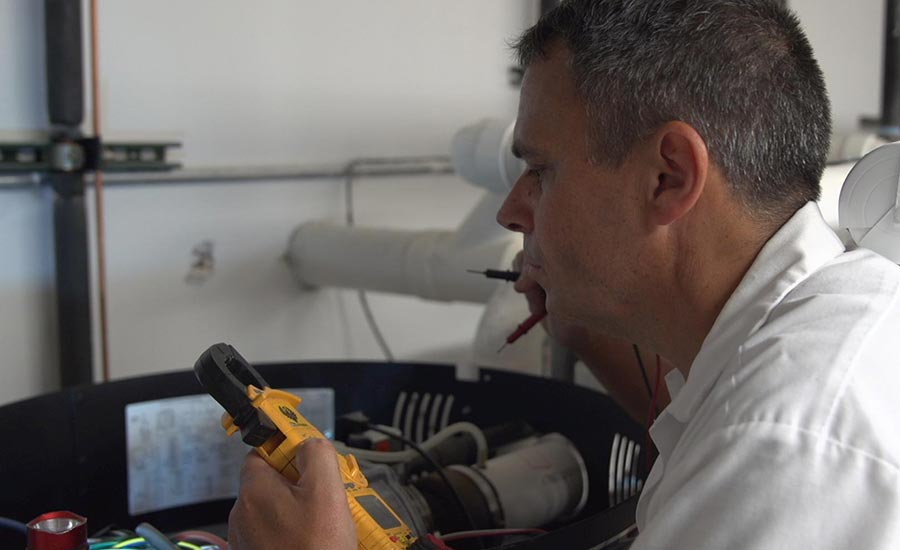
Bradford White's Kuliga Jr. notes the market will continue to trend toward higher efficiency gas, tankless and heat pump water heater products over the next few years.
Looking ahead
So, what can engineers expect next in the commercial water heating sector?
“The market will continue to trend toward higher efficiency gas, tankless and heat pump water heater products,” Kuliga Jr. says. “Customers are looking for operational savings while various proposed federal, state and local level regulations are driving greater energy efficiency.”
Juhnke notes the market will continue to be challenged.
“We’re moving toward more of an electrified grid system for an energy source — similar to what’s happening in the auto industry,” he says. “That is going to move us toward high-efficiency heat pumps and electric water heaters. We’ll bridge that gap for several years with what I call 'co-generation equipment,' — heating water and making electricity at the same time. And then, of course, I see standard or lower-efficiency equipment falling away over time. High-efficiency is going to be the baseline as we move into the next few years.
“As we move toward that future, there’s going to be a challenge for engineers as they retrofit buildings,” Juhnke continues. “Because many old buildings are not necessarily set up for high-efficiency condensing, co-generation equipment or heat pump technology. They don't have the electrical infrastructure for heat pumps, the venting systems for the new high-efficiency equipment and they don't have the, what I call, grid agreements for co-generation for making electricity on site. It's going to be a challenge for engineers to incorporate a lot of that equipment into those older buildings. And that’s probably the majority of what will have to be upgraded over the next 10 years to bring ourselves into the new era of greenhouse gas reduction.”
There’s currently a lot of uncertainty, especially with the administration change, Pohl notes. “There’s been a lot of talk and activity on the regulation side, but there’s still uncertainty as to exactly where that is going. With the high interest in government activity regarding electrification, manufacturers — including us — are putting more focus on development of heat pump water heater technologies and products for not only the commercial sector, but also residential.
“There’s been more of an emphasis on the commercial because, with the high-efficiency of gas products, there just hasn't been as much incentive for more commercial users to move over to heat pumps,” he continues. “With the electrification efforts in some parts of the country, they've actually outlawed the installation of new gas lines in new construction, so that's going to have an impact on how commercial owners make their choices moving forward. At least for now, the market seems to be moving in the direction of electrification, and with the current technology being what it is, means we're going to begin seeing more and more activity in the heat pump water heater sector in commercial markets.”
Pugh notes streamlining processes continues to be a focus.
“With some of our larger commercial customers, there has been a continued move to BMS to better manage their systems building-wide,” he says. “We ensure our Rheem products are compatible with BMS to easily provide alerts, monitor the water heater and streamline diagnostics, providing a significant advantage to building engineers at large facilities. We have also worked to streamline processes for the commercial plumber. For example, with our Rheem Triton water heater it provides informative error codes with more than 80 different alerts. This eliminates the guesswork and helps guide the commercial plumber to the exact problem, so it can be addressed more efficiently.”
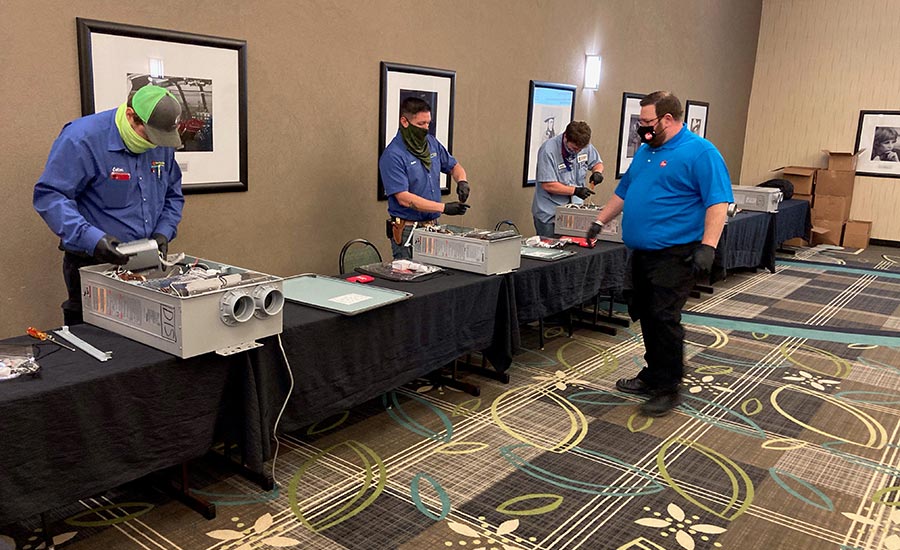
Rheem continued offering training on its water heater products during the COVID-19 pandemic.


